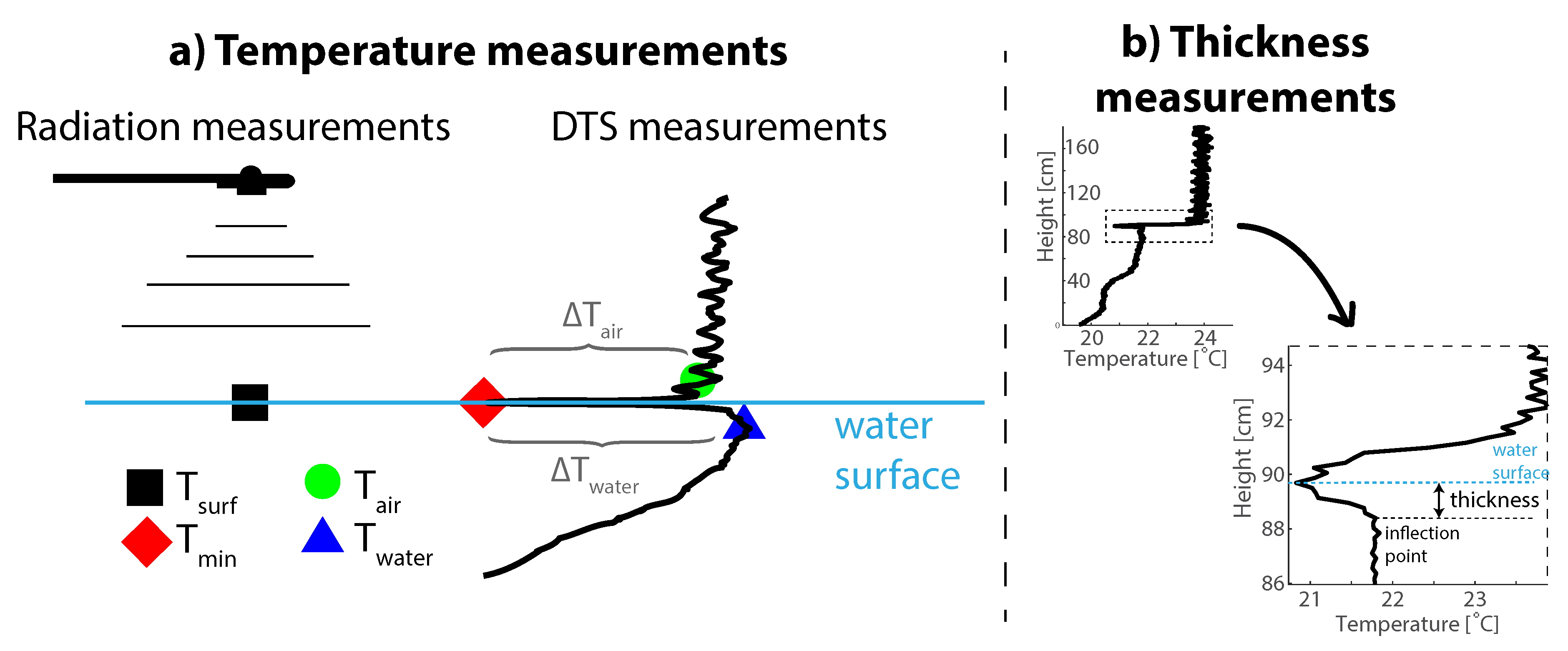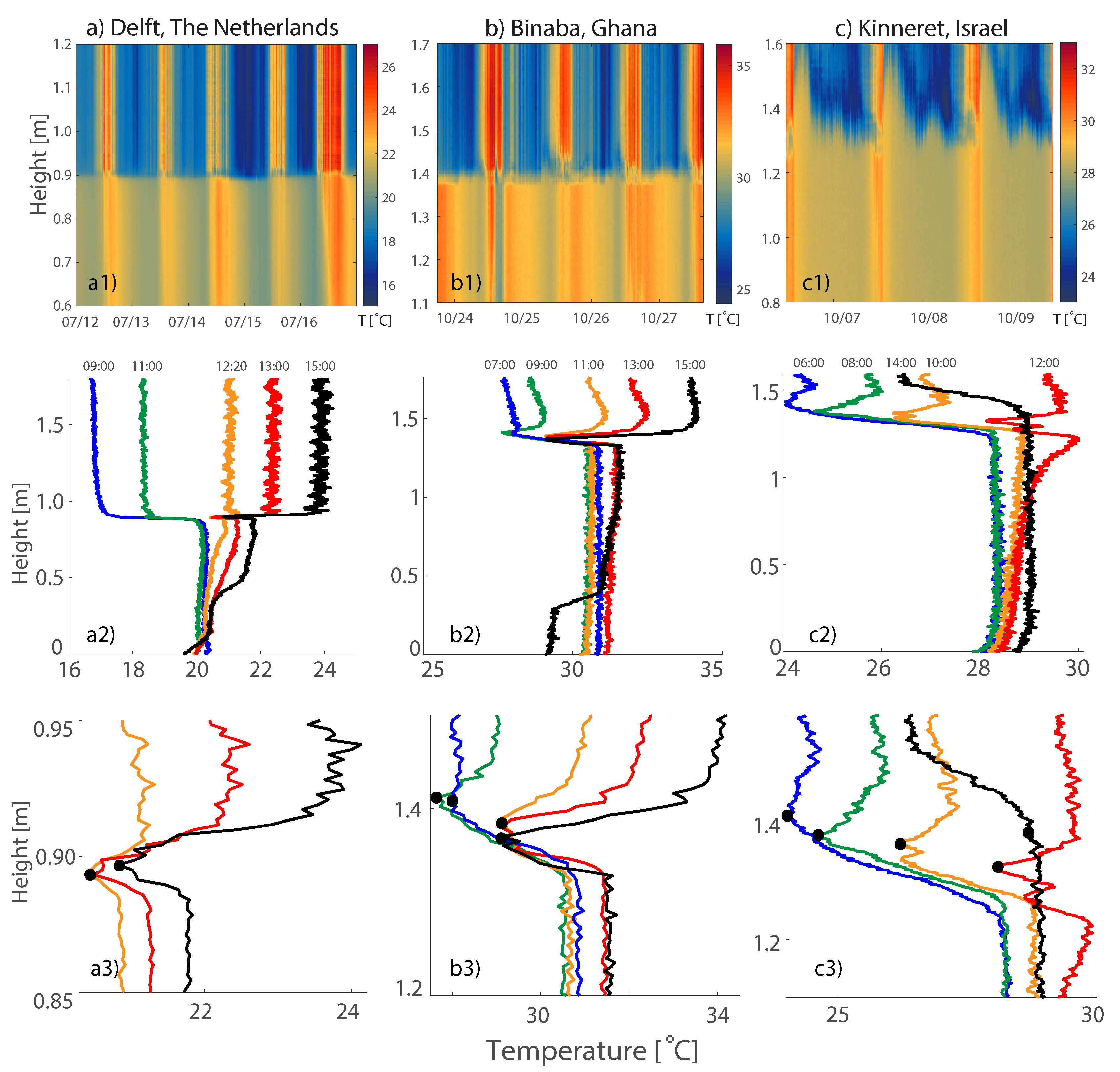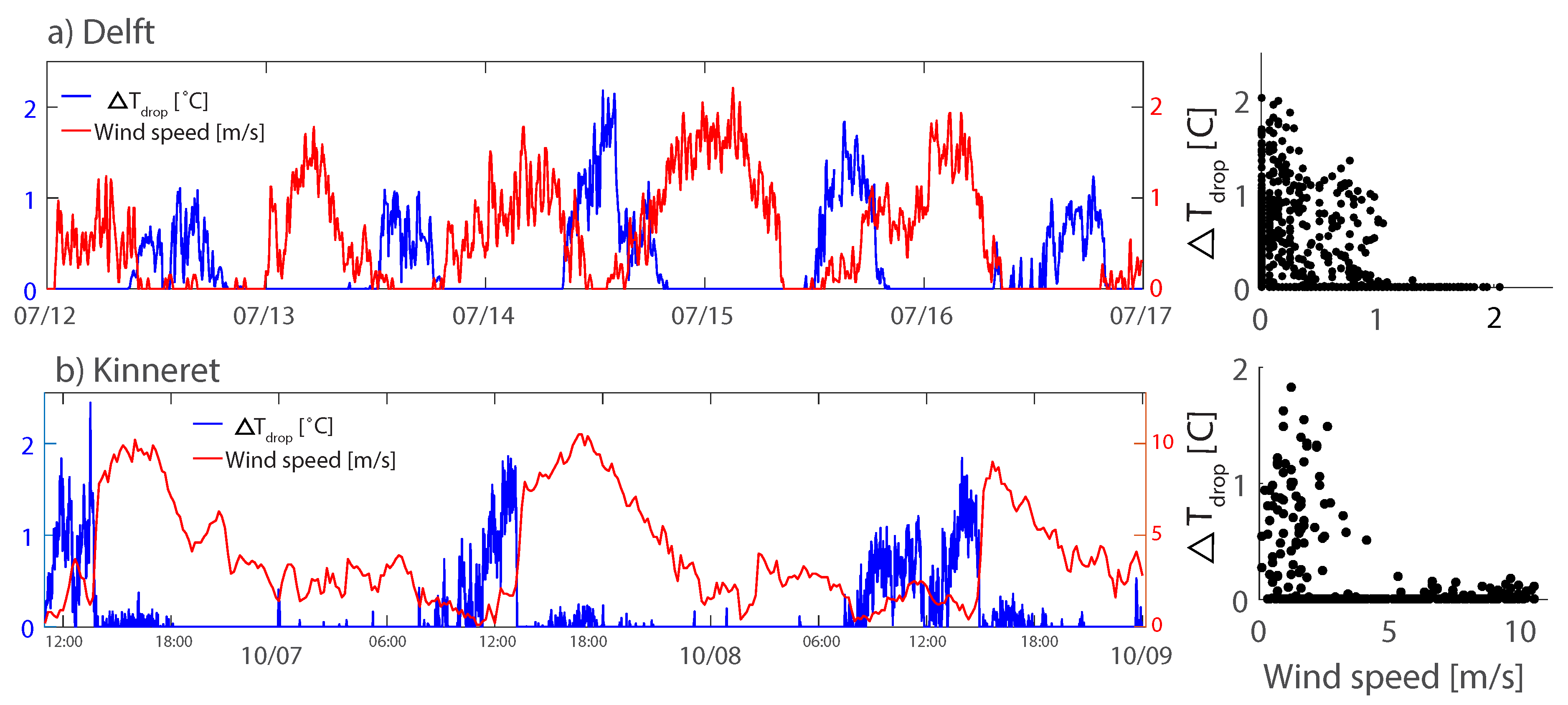Skin Effect of Fresh Water Measured Using Distributed Temperature Sensing
Abstract
1. Introduction
2. Materials and Methods
2.1. High-Resolution Measurements
2.2. Measured and Calculated Variables
2.3. Measurement Locations and Monitoring Equipment
2.3.1. Delft Pond
2.3.2. Lake Binaba
2.3.3. Lake Kinneret
3. Results
3.1. Surface Temperature
3.2. Energy Balance of Water Surface
4. Discussion
5. Conclusions
Acknowledgments
Author Contributions
Conflicts of Interest
References
- Henderson-Sellers, B. Calculating the surface energy balance for lake and reservoir modeling: A review. Rev. Geophys. 1986, 24, 625–649. [Google Scholar] [CrossRef]
- Tanny, J.; Cohen, S.; Assouline, S.; Lange, F.; Grava, A.; Berger, D.; Teltch, B.; Parlange, M. Evaporation from a small water reservoir: Direct measurements and estimates. J. Hydrol. 2008, 351, 218–229. [Google Scholar] [CrossRef]
- Van Emmerik, T.; Rimmer, A.; Lechinsky, Y.; Wenker, K.; Nussboim, S.; Van de Giesen, N. Measuring heat balance residual at lake surface using Distributed Temperature Sensing. Limnol. Oceanogr. Methods 2013, 11, 79–90. [Google Scholar] [CrossRef]
- Nordbo, A.; Launiainen, S.; Mammarella, I.; Leppäranta, M.; Huotari, J.; Ojala, A.; Vesala, T. Long-term energy flux measurements and energy balance over a small boreal lake using eddy covariance technique. J. Geophys. Res. Atmos. 2011, 116. [Google Scholar] [CrossRef]
- Solcerova, A.; van de Ven, F.; van de Giesen, N. Nighttime cooling of an urban pond. submitted.
- Vercauteren, N.; Huwald, H.; Bou-Zeid, E.; Selker, J.S.; Lemmin, U.; Parlange, M.B.; Lunati, I. Evolution of superficial lake water temperature profile under diurnal radiative forcing. Water Resour. Res. 2011, 47. [Google Scholar] [CrossRef]
- Selker, J.S.; Thevenaz, L.; Huwald, H.; Mallet, A.; Luxemburg, W.; Van De Giesen, N.; Stejskal, M.; Zeman, J.; Westhoff, M.; Parlange, M.B. Distributed fiber-optic temperature sensing for hydrologic systems. Water Resour. Res. 2006, 42. [Google Scholar] [CrossRef]
- Minnett, P.J.; Smith, M.; Ward, B. Measurements of the oceanic thermal skin effect. Deep Sea Res. Part II Top. Stud. Oceanogr. 2011, 58, 861–868. [Google Scholar] [CrossRef]
- Fairall, C.; Bradley, E.F.; Godfrey, J.; Wick, G.; Edson, J.B.; Young, G. Cool-skin and warm-layer effects on sea surface temperature. J. Geophys. Res. 1996, 101, 1295–1308. [Google Scholar] [CrossRef]
- Saunders, P.M. The temperature at the ocean-air interface. J. Atmos. Sci. 1967, 24, 269–273. [Google Scholar] [CrossRef]
- Edinger, J.E.; Brady, D.K.; Geyer, J.C. Heat Exchange and Transport in the Environment; Report No. 14; Technical Report; Department of Geography and Environmental Engineering, Johns Hopkins University: Baltimore, MD, USA, 1974. [Google Scholar]
- Ward, B.; Minnett, P.J. An autonomous profiler for near surface temperature measurements. In Gas Transfer at Water Surfaces; Springer Science & Business Media: Berlin, Germany, 2002; pp. 167–172. [Google Scholar]
- Ridley, I.K.; Lawrence, S.P.; Llewellyn-Jones, D.T.; Parkes, I.M.; Yokoyama, R.; Tanba, S.; Oikawa, S. Use of ATSR-measured ocean skin temperatures in ocean and atmosphere models. In Proceedings of the Third ERS Symposium on Space at the Service of Our Environment, Florence, Italy, 14–21 March 1997; pp. 1317–1321. [Google Scholar]
- Kang, H.J.; Yoo, J.M.; Jeong, M.J.; Won, Y.I. Uncertainties of satellite-derived surface skin temperatures in the polar oceans: MODIS, AIRS/AMSU, and AIRS only. Atmos. Meas. Tech. 2015, 8, 4025–4041. [Google Scholar] [CrossRef]
- Hardy, J. The sea surface microlayer: Biology, chemistry and anthropogenic enrichment. Prog. Oceanogr. 1982, 11, 307–328. [Google Scholar] [CrossRef]
- Bidleman, T.; Olney, C. Chlorinated hydrocarbons in the Sargasso Sea atmosphere and surface water. Science 1974, 183, 516–518. [Google Scholar] [CrossRef] [PubMed]
- Woodcock, A.H.; Stommel, H. Temperatures Observed Near the Surface of a Fresh-Water Pond at Night. J. Atmos. Sci. 1947, 4, 102–103. [Google Scholar] [CrossRef]
- Wilson, R.C.; Hook, S.J.; Schneider, P.; Schladow, S.G. Skin and bulk temperature difference at Lake Tahoe: A case study on lake skin effect. J. Geophys. Res. Atmos. 2013, 118. [Google Scholar] [CrossRef]
- Schluessel, P.; Emery, W.J.; Grassl, H.; Mammen, T. On the bulk-skin temperature difference and its impact on satellite remote sensing of sea surface temperature. J. Geophys. Res. Oceans 1990, 95, 13341–13356. [Google Scholar] [CrossRef]
- Jessup, A.; Branch, R. Integrated ocean skin and bulk temperature measurements using the calibrated infrared in situ measurement system (CIRIMS) and through-hull ports. J. Atmos. Ocean. Technol. 2008, 25, 579–597. [Google Scholar] [CrossRef]
- Grassl, H. The dependence of the measured cool skin of the ocean on wind stress and total heat flux. Bound. Layer Meteorol. 1976, 10, 465–474. [Google Scholar] [CrossRef]
- Duan, F.; Thompson, I.; Ward, C. Statistical rate theory determination of water properties below the triple point. J. Phys. Chem. B 2008, 112, 8605–8613. [Google Scholar] [CrossRef] [PubMed]
- Hisatake, K.; Tanaka, S.; Aizawa, Y. Evaporation rate of water in a vessel. J. Appl. Phys. 1993, 73, 7395–7401. [Google Scholar] [CrossRef]
- Euser, T.; Luxemburg, W.; Everson, C.; Mengistu, M.; Clulow, A.; Bastiaanssen, W. A new method to measure Bowen ratios using high-resolution vertical dry and wet bulb temperature profiles. Hydrol. Earth Syst. Sci. 2014, 18, 2021–2032. [Google Scholar] [CrossRef]
- De Jong, S.; Slingerland, J.; Van de Giesen, N. Fiber optic distributed temperature sensing for the determination of air temperature. Atmos. Meas. Tech. 2015, 8, 335–339. [Google Scholar] [CrossRef]
- Westhoff, M.; Savenije, H.; Luxemburg, W.; Stelling, G.; Van de Giesen, N.; Selker, J.; Pfister, L.; Uhlenbrook, S. A distributed stream temperature model using high-resolution temperature observations. Hydrol. Earth Syst. Sci. 2007, 11, 1469–1480. [Google Scholar] [CrossRef]
- Sebok, E.; Duque, C.; Kazmierczak, J.; Engesgaard, P.; Nilsson, B.; Karan, S.; Frandsen, M. High-resolution distributed temperature sensing to detect seasonal groundwater discharge into Lake Væng, Denmark. Water Resour. Res. 2013, 49, 5355–5368. [Google Scholar] [CrossRef]
- Steele-Dunne, S.; Rutten, M.; Krzeminska, D.; Hausner, M.; Tyler, S.; Selker, J.; Bogaard, T.; Van de Giesen, N. Feasibility of soil moisture estimation using passive distributed temperature sensing. Water Resour. Res. 2010, 46. [Google Scholar] [CrossRef]
- Bense, V.; Read, T.; Verhoef, A. Using distributed temperature sensing to monitor field scale dynamics of ground surface temperature and related substrate heat flux. Agric. For. Meteorol. 2016, 220, 207–215. [Google Scholar] [CrossRef]
- Tyler, S.W.; Selker, J.S.; Hausner, M.B.; Hatch, C.E.; Torgersen, T.; Thodal, C.E.; Schladow, S.G. Environmental temperature sensing using Raman spectra DTS fiber-optic methods. Water Resour. Res. 2009, 45. [Google Scholar] [CrossRef]
- Hilgersom, K.; van de Giesen, N.; de Louw, P.; Zijlema, M. Three-dimensional dense distributed temperature sensing for measuring layered thermohaline systems. Water Resour. Res. 2016, 52, 6656–6670. [Google Scholar] [CrossRef]
- Hilgersom, K.; Van Emmerik, T.; Solcerova, A.; Berghuijs, W.; Selker, J.; Van de Giesen, N. Practical considerations for enhanced-resolution coil-wrapped Distributed Temperature Sensing. Geosci. Instrum. Method. Data Syst. 2016, 5, 151–162. [Google Scholar] [CrossRef]
- Van De Giesen, N.; Steele-Dunne, S.C.; Jansen, J.; Hoes, O.; Hausner, M.B.; Tyler, S.; Selker, J. Double-ended calibration of fiber-optic Raman spectra distributed temperature sensing data. Sensors 2012, 12, 5471–5485. [Google Scholar] [CrossRef] [PubMed]
- Wen-Yao, L.; Field, R.; Gantt, R.; Klemas, V. Measurement of the surface emissivity of turbid waters. Remote Sens. Environ. 1987, 21, 97–109. [Google Scholar] [CrossRef]
- Hausner, M.B.; Suárez, F.; Glander, K.E.; Giesen, N.v.d.; Selker, J.S.; Tyler, S.W. Calibrating single-ended fiber-optic Raman spectra distributed temperature sensing data. Sensors 2011, 11, 10859–10879. [Google Scholar] [CrossRef] [PubMed]
- Hilgersom, K.; Zijlema, M.; van de Giesen, N. An axisymmetric non-hydrostatic model for double-diffusive water systems. Geosci. Model Dev. 2018, 11, 521–540. [Google Scholar] [CrossRef]







© 2018 by the authors. Licensee MDPI, Basel, Switzerland. This article is an open access article distributed under the terms and conditions of the Creative Commons Attribution (CC BY) license (http://creativecommons.org/licenses/by/4.0/).
Share and Cite
Solcerova, A.; Van Emmerik, T.; Van de Ven, F.; Selker, J.; Van de Giesen, N. Skin Effect of Fresh Water Measured Using Distributed Temperature Sensing. Water 2018, 10, 214. https://doi.org/10.3390/w10020214
Solcerova A, Van Emmerik T, Van de Ven F, Selker J, Van de Giesen N. Skin Effect of Fresh Water Measured Using Distributed Temperature Sensing. Water. 2018; 10(2):214. https://doi.org/10.3390/w10020214
Chicago/Turabian StyleSolcerova, Anna, Tim Van Emmerik, Frans Van de Ven, John Selker, and Nick Van de Giesen. 2018. "Skin Effect of Fresh Water Measured Using Distributed Temperature Sensing" Water 10, no. 2: 214. https://doi.org/10.3390/w10020214
APA StyleSolcerova, A., Van Emmerik, T., Van de Ven, F., Selker, J., & Van de Giesen, N. (2018). Skin Effect of Fresh Water Measured Using Distributed Temperature Sensing. Water, 10(2), 214. https://doi.org/10.3390/w10020214




